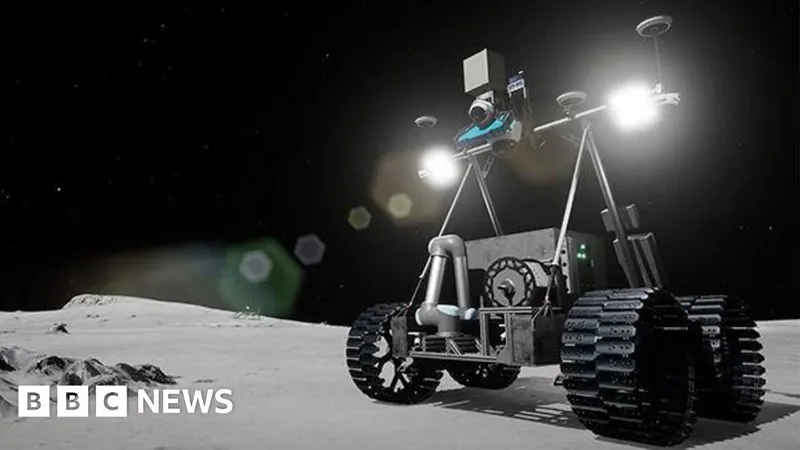
Canada's Groundbreaking Lunar Rover: Pioneering the Future of Space Exploration
2025-08-31
Author: Emily
A New Era for Canada's Space Ambitions
In a humble two-storey building nestled in a shopping plaza an hour outside of Toronto, Canadensys Aerospace is on a mission that could alter the course of space exploration. This facility is brimming with innovative minds developing Canada's first-ever lunar rover, marking a momentous milestone for the nation in the realm of planetary exploration.
Charting the Unknown: The Rover's Mission
The ambitious rover is part of NASA's Artemis program, which aims to establish a sustainable human presence on the Moon. This Canadian marvel is set to search for water and measure radiation levels on the lunar surface, crucial for future manned missions. Dr. Christian Sallaberger, the company's president, highlights that learning about the Moon is the "logical first step" in pushing humanity beyond Earth.
Harnessing Canadian Ingenuity and History
Canada's contributions to space are notable: from launching its first satellite to developing the iconic Canadarm robotic arms utilized on the Space Shuttle and the International Space Station. This rover will not only showcase Canadian technological prowess but also build on this impressive legacy.
Facing the Harsh Lunar Environment
Set to launch no earlier than 2029, the rover will land in the Moon's treacherous south polar region. Here, temperatures plunge to a bone-chilling -200°C (-328°F) during lunar nights and soar to a scorching 100°C (212°F) in daylight. This extreme temperature fluctuation poses one of the greatest engineering challenges, but the team is determined to prove that their rover can withstand the Moon’s harsh conditions.
Unraveling the Mystery of Lunar Water
Recent revelations about lunar water have reignited interest in the Moon's potential for future exploration. Past assumptions deemed the Moon dry, but a 2008 analysis of Apollo samples revealed water particles, shifting our understanding dramatically. Dr. Gordon Osinski, chief scientist of the mission, emphasizes that determining the size and accessibility of these water deposits could reshape exploration strategies.
The Implications of Water and Resources
The prospect of water on the Moon could revolutionize how missions are conducted. Water not only supports human life but can also be converted into hydrogen for rocket fuel. Imagine the Moon serving as a fuel station for spacecraft—this idea is not just visionary; it’s fast becoming a realistic goal.
A Long-Desired Vision Finally Comes to Life
The dream of a Canadian lunar vehicle has been unfulfilled for decades. Concrete plans only materialized in 2019, followed by a significant contract in 2022, underscoring a new chapter for Canadian space adventures. With over 20 instruments already deployed on Moon missions, Canadensys is ready to take this bold leap.
Navigating Challenges Ahead
Despite the excitement, challenges loom large. Past attempts by other nations to land on the Moon have met with failure, reminding us that space exploration is fraught with unpredictability. However, the spirit of collaboration remains crucial; countries are increasingly partnering for missions, moving beyond historical rivalries.
The Future of Lunar Exploration and Beyond
As space becomes ever more accessible, the Moon stands as the Holy Grail for exploration. Canadensys aims not just for the rover but for long-term endeavors, like lunar greenhouses for sustainable food production. This rover represents more than just a vehicle; it symbolizes humanity's tenacity to explore and adapt, paving the way for future missions beyond our own planet.









 Brasil (PT)
Brasil (PT)
 Canada (EN)
Canada (EN)
 Chile (ES)
Chile (ES)
 Česko (CS)
Česko (CS)
 대한민국 (KO)
대한민국 (KO)
 España (ES)
España (ES)
 France (FR)
France (FR)
 Hong Kong (EN)
Hong Kong (EN)
 Italia (IT)
Italia (IT)
 日本 (JA)
日本 (JA)
 Magyarország (HU)
Magyarország (HU)
 Norge (NO)
Norge (NO)
 Polska (PL)
Polska (PL)
 Schweiz (DE)
Schweiz (DE)
 Singapore (EN)
Singapore (EN)
 Sverige (SV)
Sverige (SV)
 Suomi (FI)
Suomi (FI)
 Türkiye (TR)
Türkiye (TR)
 الإمارات العربية المتحدة (AR)
الإمارات العربية المتحدة (AR)